#pixelshifting
Photo

Rhinoceros beetle 160MP photo shot with Fujifilm XH2 + XF30mm #fujifilm #fujifilmxindia #pixelshift #macrophotography #macrophoto #insectguru #arthropod_perfection #fujifilm_xseries #gulfuphotography #macroworld #radiantdiffuser #insect_perfection #ultramacro (at Kochi, India) https://www.instagram.com/p/Cp7sextSnL0/?igshid=NGJjMDIxMWI=
#fujifilm#fujifilmxindia#pixelshift#macrophotography#macrophoto#insectguru#arthropod_perfection#fujifilm_xseries#gulfuphotography#macroworld#radiantdiffuser#insect_perfection#ultramacro
5 notes
·
View notes
Text
Computational Photography
Vor kurzem habe ich an dieser Stelle die unterschiedlichen – auch philosophischen – Entstehungsansätze analoger und digitaler Fotografie besprochen, die für mich deswegen beinahe zwei eigenständige Kunstformen darstellen.
Die Disziplin der digitalen Fotografie muss aber isoliert genauer betrachtet werden, und das in Zukunft regelmäßig – zu groß sind die technologischen Sprünge, die sich aus (in erster Linie) software- und auch hardwaretechnischen Möglichkeiten ergeben.
Computational Photography: Hardware
Zum Umfeld der Hardware zähle ich in erster Linie die Bildsensoren und ihre ‚Aufhängung‘ im Gehäuse, die die vom Sensor erfassten Daten verarbeitenden Bildprozessoren sowie den Datenbus, der beide Instanzen verbindet und möglichst viel Durchsatz aufbringen sollte. Die Entwicklung macht große Fortschritte, aber bei weitem nicht in dem Maße, wie es aktuell auf dem Gebiet der Software passiert, zu der ich gleich komme.
Der Trend zu immer mehr Auflösung bei gleichzeitig höheren High-ISO-Fähigkeiten zeigt erstaunliche Ergebnisse, ich halte sie aber nicht für so wichtig wie zum Beispiel die schwebende Sensoraufhängung im Kameragehäuse (In Body Image Stabilization – ‚IBIS‘), mit der rund 5 Stops Bildstabilisation, Pixelshifting für zusammengestitchte, höchstauflösende (aktuell noch statische) Motive, Fokus-Stacking und so weiter realisiert werden, und in der Astrofotografie eröffnen sich durch mitschwenkende Sensoren ganz neue Möglichkeiten bei Langzeitbelichtungen ohne Startrails.
Zusammen mit den immer leistungsfähiger werdenden Bildprozessoren werden hier schon beim Stills-Bild Datenmengen verarbeitet, die eine Desktop-Workstation im harten Photoshop-Einsatz locker in den Schatten stellen.
Auf Grund der dafür benötigten Rechenpower eine Erklärung für die von manchem als ‚zu teuer‘ bezeichneten Kamera-Bodies.
Mittlerweile auch Mainstream-Technologie: Die Verwendung von PDA-Fokuspixeln auf Sensoren macht es möglich, dass aktuelle spiegellose Kameras das Fokus-Tracking bei Bewegtobjekten mittlerweile fast auf DSLR-Niveau bewältigen.
Computational Photography: Software
Auch diese PDA-Pixel wären ohne Software nutzlos, beim Tracking bewegter Objekte helfen beispielsweise die entsprechenden Algorithmen für Eye-AF und verschiedene Fokus Szenarien. Es ergibt sich außerdem die Möglichkeit, vorhandener Hardware durch Software-Updates ständig neues Leben einzuhauchen; Kameras sind nach dem Aufspielen eines Firmware-Updates im Fokusverhalten teilweise nicht mehr wiederzuerkennen, und das im positiven Sinn. Es bleibt zu hoffen, dass die Hersteller hier im Sinne des Kunden am Ball bleiben, natürlich ergibt sich hier verlockendes Potential für aufpreispflichtige Freischaltungen von im Code längst vorhandenen Features oder gar eine gewollte Obsoleszenz durch gezielte Entwicklungsstops.
Der ursprünglichen Software-Seite der Computational Photography nähern wir uns am besten über die Mobile Phone-Photography an.
Die in diesem Sektor nötige Miniaturisierung bedingt Schwächen bei der Kamera-Hardware, denen die Hersteller per Software beizukommen versuchen. Kleinere Sensoren, wenig Platz für weiterverarbeitende Chipsätze und eingeschränkte Möglichkeiten bei der Objektiv-Konstruktion etc. schließen Anwendungen wie Portrait- und Night-Mode eigentlich aus, mit weitreichenden Software-Tweaks und den neuesten Erkenntnissen aus den KI-Labors werden jetzt schon erstaunliche Ergebnisse erzielt, die Spitzenphones von Apple und Google weisen mittlerweile Lowlight-Perfomances auf, die auch Pro-Fotografen mit Blick auf die Fähigkeiten ihrer zigtausend Euro teuren Ausrüstung mit offenem Mund zurücklassen.
Klar, die kleinen Sensoren bilden in diesen speziellen Szenarien ein Feature, das aus dem Bug erwuchs: Die Sensoren mit erstaunlicher Pixeldichte müssen mit wahnwitzigem Tempo ausgelesen werden, damit auf Teufel komm raus gestitched und composed werden kann, und was hinten rauskommt, reicht für die Hauptanwendungsgebiete der mobile Photography (Social Media) immer aus. Noch. Mir scheint, dass die Entwicklung gerade erst richtig begonnen hat. Was mich unweigerlich zu der Frage kommen lässt, ob der Trend zum immer größeren bzw. größeren und gleichzeitig höher auflösenden Sensor (Crop-Mittelformat nähert sich langsam dem Mainstream, Vollformat hat diesen Status längst erreicht) bei reiner Kamera-Hardware aufrecht erhalten werden kann, oder ob die Margen der Hersteller durch die Verwendung schlankerer Sensoren, die von höchstentwickelter Software und ultraleistungsfähigen Bildprozessoren unterstützt werden, wieder erhöht werden können. Eventuell müssen. Die Verkäufe sind eingebrochen, der Verdrängungswettbewerb ist in vollem Gange. Vielleicht rückte durch ein Umdenken in Bezug auf Downsizing bei der Hardware-Sensorauflösung auch der schon lange erwartete technologische Quantensprung des ‚Global Shutter‘ in eine nähere Zukunft – durch das Auslesen des gesamten Sensors in einem ‚Snapshot‘ statt zeilenweiser Erfassung der Pixel würden bei der Anwendung im Videobereich Verzerrungen bei sich bewegenden Objekten (‚Rolling Shutter’) der Vergangenheit angehören und im Stills-Bereich könnten mit dem dann nur noch benötigten elektronischem Verschluss (Produktionskosten!) ultraschnelle Belichtungszeiten realisiert werden.
Ein Beispiel im Sinne ‘kleinerer Sensor kann Vorteile haben’ aus der heutigen Realität: Noch immer gehört die Panasonic Lumix GH-5S zu den Referenzen im datenintensiven Videobereich, ihr MicroFourThirds-Sensor macht die Maschine nicht so anfällig für Überhitzung und Rolling Shutter-Effekte. Es bleibt abzuwarten, wie gut die Bildprozessoren mit den Sensorauflösungen mitkommen, aber deren Entwicklung und Produktion kosten halt mehr als die Software weiterzuentwickeln.
Und gut möglich, dass gerade eine von der Smartphone-Fotografie geprägte Neukunden-Generation für die Foto-Industrie heranwächst, die mit einem traditionellen Technik-Ansatz nichts anfangen kann oder will, klassische Kamerahersteller müssten dann beweglicher werden und z.B. einen Technologie-Transfer vom Smartphone in Richtung ihrer Kamera-Bodies zulassen und nutzen – nicht zuletzt in Sachen Connectivity, Stichworte 5G, automatische Cloud-Uploads etc.
Stop, Stop, Stop!
Bis jetzt liest sich dieses Stück wie eine nerdige Computer-Story, und eigentlich ist es genau das, worauf ich hinaus wollte. Für Fotografen der klassischen Schule klingt all das eklig technokratisch, und auch in meinem Hirn werden für die wunderbare Beschäftigung mit der Fotografie komplett andere Hirnbereiche angesprochen, als es das bis hierhin beschschriebene Technik-Feuerwerk getan hat.
Und die rein sensorische Erfassung eines Stücks analoger Realität und ihre Umwandlung in eine elektronisch interpretierbare Datei ist eine Sache. Aber die megakomplexe, nicht mehr in der Hand des Fotografen liegende In-Body-Weiterverarbeitung dieser Rohdaten hin zu einem Ergebnis, das nicht mehr im künstlerischen Fokus des Fotografen liegen muss, scheint gerade erst richtig Fahrt aufzunehmen.
Ich versuche, technische Entwicklungen auf dem Gebiet der Fotografie interessiert zu verfolgen und so weit wie möglich für mich zu nutzen. Doch irgendwann wird der persönliche Tipping Point erreicht, der eigene fotografisch/ künstlerische Anspruch von der technologischen Entwicklung überrollt. Oder drastischer ausgedrückt: Beide geraten in Konflikt miteinander.
Trendbarometer Fotografie?
Womit ich den Bogen in Richtung Trends, Mainstream und Social Media spannen möchte. Dieses Feld entwickelt sich gerade im Moment mit Lichtgeschwindigkeit weg von meinem persönlichen fotografischen Anspruch und Ansatz, Stichworte Rauchbomben, Überretuschieren, ungehemmtes Abfeiern eines Technik- und Ego-Fetischs – Motive, die von Weitem erkennen lassen, dass es sich um digitale Retortenprodukte handelt, die näher an einer virtual Reality sind als an der Welt, aus der sie ursprünglich mal stammten. Stile und Accessoirs sind auf breiter Front identisch, neu auftauchende Trend-Trittbretter sind ruckzuck überfüllt.
Auch hier versuche ich möglichst die gesellschaftlich/ philosophische Komponente zu verstehen, will nicht verurteilen, mich höchstens wundern, erkenne aber auch, dass ich in meinen eigenen Augen zu denen gehöre, die bewusst zurückbleiben und dem abfahrenden Zug hinterherwinken. Andere haben das schon viel früher getan. Dennoch scheint mir ein Zusammenwirken dieser eher massentauglichen Prosumer-Trends und den sich ständig weiterentwickelnden technischen Möglichkeiten zu bestehen, letztlich sind die entstehenden Motive der eben beschriebenen Art ein Ausnutzen des sich bietenden Potentials der Hard- und Software, was konsequenterweise zu einer Art digitalen Karikatur führt. Die wiederum als ein Spiegel gesellschaftlicher Strömungen interpretiert werden kann.
Interessant im eher politisch/ gesellschaftlichen Zusammenhang fand ich einen Artikel, der auf die Veränderung der Bildsprache von professionellen Fotografen im Zuge der Ära Trump und des nun Fahrt aufnehmenden US-Präsidentschaftswahlkampfs (‚Campaigning‘) 2020 eingeht.
Details aus diesem Artikel (XXX Link!) lasse ich hier aus, und ich beschränke mich auf die allein fotografisch interessanten Hinweise darauf, dass sich die Pro-Togs in ihre Wagenburg zurückziehen und mit Bildkomposition und Lichtwahl (= wenig davon) so arbeiten, dass sie a) teures Pro-Material im schmalen Schärfentiefe-Bereich so nutzen (die gewählten Bildkompositionen würden die KI-Software im ‚Portrait‘-Modus eines Smartphones [noch] vor Probleme stellen und sie zumindest bei genauerer Betrachtung des Ergebnisses als solche auffliegen lassen), dass sie sich von den ‚Jeder-ist-immer-Reporter‘-Fotografen mit Smartphones differenzieren können (Preisgestaltung/ -rechtfertigung!). Es findet im Grunde aktuell ein Kampf Hard- gegen Software statt, wobei Zweitere für eine weitere Demokratisierung in der Fotografie sorgen wird.
Die Diskussion, dass b) mit der Ära Trump eine dunklerere/ düsterere Bildwelt verknüpft wird, könnte mit Punkt a) unter Umständen durch einen simplen, technischen Argumentationspunkt begründet bzw. miterklärt werden – für Aluhutträger und Verschwörungstheoretiker mögen es eher die dunklen Wolken der herannahende Apokalypse sein.
Was bedeutet das alles für mich?
Mir ist auf dem Feld der fotografischen Werkzeuge eine Reduktion aufs Wesentliche sehr sympathisch, da es meinem Konzept entgegenkommt.
Es macht mir ein bisschen Angst, dass ich nach verbittertem, alten weißen Mann klingen könnte, der mit dem Fortschritt und den daraus folgenden Umbrüchen nicht mehr klarkommt; dass ich mich mit der technischen Entwicklung auseinandersetze, dürfte dieser Text gezeigt haben.
Das Ergebnis dieser Auseinandersetzung ist, dass ich für mich das ‚computational‘ in Photography ablehne, sobald ich es nicht mehr beeinflussen kann. Selbst tiefe, aber gewollte ‚Eingriffe‘ im Post-Processing – also z.B. Bildretuschen per Photoshop – sind je nach fotografischem Genre für mich absolut legitim, bei konzeptioneller Arbeit vielleicht sogar so etwas wie selbstverständlich.
Weitere allgemeine und persönliche Konsequenzen
Die Demokratisierung der Fotografie befindet sich also gerade in einer superheißen Phase, und wir können diese Aussage eher nicht an den Entwicklungen im Bereich neuer Kamera-Ökosysteme festmachen (z.B. Eintritt zweier Big Player in den Spiegellos-Markt).
‚Power to the People‘ ist etwas, das ich immer unumwunden unterstütze. Für mich selber kommt die fortschreitende Demokratisierung in der Fotografie eher nicht (mehr) zum Tragen, da ich eh schon lange fotografiere und die zu ihr führenden technischen Maßnahmen und Workflows nicht mehr der von mir so geliebten, befriedigenden ‚User Experience‘ entsprechen.Wie sich dieser gesamte Themenkomplex auf die Bilder da draußen in Qualität und Quantität auswirken wird, hatte ich an anderer Stelle schon gemutmaßt, wahrscheinlich wird der Faktor Mensch in Zukunft auch in der Fotografie in erster Linie durch das Setzen von Trends, kreativem Storytelling und gewollt herbeigeführten Brüchen bis Fehlern für Alleinstellungsmerkmale sorgen können; etwas, das sich so durch ziemlich alle Bereiche der Arbeitswelt und Gesellschaft ziehen wird und auf das wir uns einstellen sollten.
Essay 'Computational Photography' © JS 2020
·
#essay#fotografie#fototheorie#deutscher text#deutschsprachiger text#schrammels schreibsalon#exofiktionale fiktion
0 notes
Text
AMOLED display phones Review
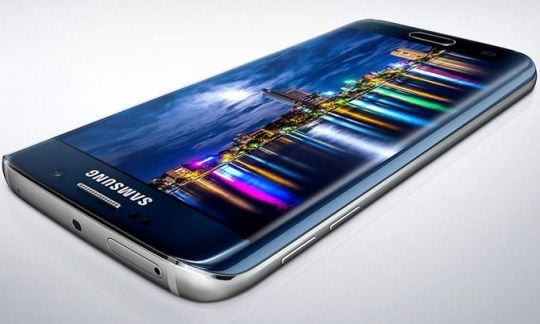
Of course, a modern smartphone is one of the most complex electronic devices that uses a large number of complex components. Their technical characteristics directly affect the functionality and, as a result, the choice of the optimal model. This list includes the number and set of cameras in multi-camera smartphones and specs on main camera, smartphone performance and smartphone storage, operation system, etc.
Of course, the display is one of the main components. But its specs, service life and safety for vision depend on the matrix type. All modern TVs and smartphones use AMOLED (Active Matrix Organic Light-Emitting Diode) or LCD screens.
As known, the first light-emitting p-phenylene vinylene (or PPV, or polyphenylene vinylene) polymer was synthesized in the Cavendish Laboratory of the University of Cambridge in 1989. Already in 1992, Cambridge Display Technolodgy (CDT) was established to produce polymer light-emitting materials.
In 2004, Samsung introduced the first X120 phone with an OLED screen.
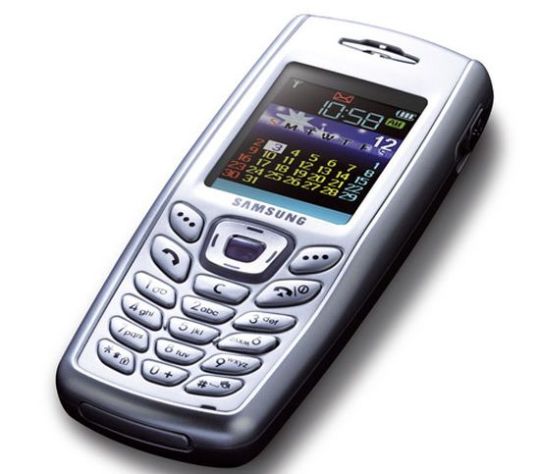
In August 2008, Nokia introduced the N85 with an AMOLED display.
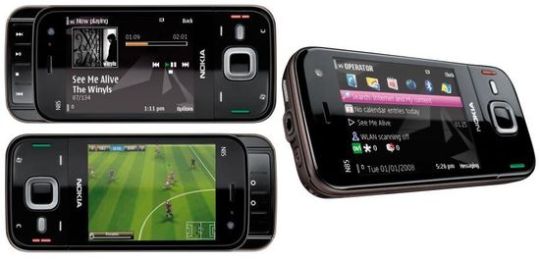
As known, OLED matrices (Organic light-emitting diode) use multilayer organic polymers that emit light under the influence of an electric current. Accordingly, they do not require backlighting. This factor is their main difference from traditional LCD technology. Today, all companies use OLED matrices with Active Matrix only and are called AMOLED (Active Matrix Organic light-emitting diode). In the TVs segment, companies continue to use OLED abbreviation without adding AM.
Pros & Cons
Pros
- perfect black due to lack of backlight provides almost endless contrast (2,000,000: 1 and above);
- large viewing angles eliminate color distortion even when viewing at an angle;
- PWM (pulse-width modulation) provides a wide range of brightness and very accurate color reproduction;
- smaller dimensions and weight;
- instant response due to lack of inertia;
- the ability to create flexible screens;
- wide range of operating temperatures from −40 to +70°C.
Cons
- high price;
- screen flicker due to PWM increases eye strain;
- low maximum brightness;
- high sensitivity to moisture;
- slight purple hue due to the eye’s reaction to the blue subpixels.
- the limited service life of the blue phosphor due to its chemical characteristics violates the color balance after several years.
The service life of green diodes reaches 130,000 hours, red - 50,000 hours, blue - only 15,000 hours. Of course, this problem significantly reduces the competitiveness of AMOLED vs LCD.
PenTile, Pixel Shifting and parallax backgrounds
Today, companies use several basic ways to solve this problem.
PenTile (penta + tile) technology integrates a family of proprietary sub-pixel configurations in electronic displays. It was developed in the early 1990s. This method uses the placement in a staggered manner of the five subpixels in each pixel, including two red, two green, and one central blue.

It is based on the characteristics of the retina of the human eye, which contains S (short)-cones, M (medium)-cones and L (long)-cones. Wherein, the number of S-cones significantly exceeds the number of M and L-cones. As known, S-cones provide recognition of blue color. Moreover, blue color almost does not affect the perception of brightness.
In March 2008, Samsung Electronics acquired PenTile from Clairvoyante and funded Nouvoyance, Inc. to continue developing this technology.
Technologically, PenTile adds subpixels to the device matrix. Modern smartphones use RGBG (additional green sub-pixel) or RGBW (additional white sub-pixel).
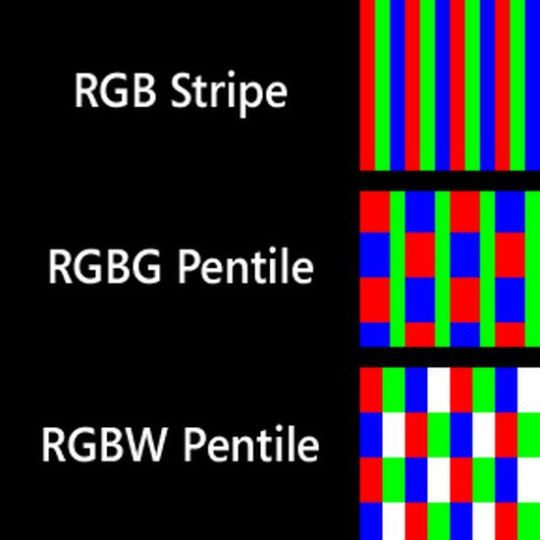
RGBG provides provides constant brightness while reducing the number of subpixels by 1/3 due to the high perception of green by the human eye. Today AMOLED, Super AMOLED and Super AMOLED HD often use this configuration.
RGBW increases brightness without increasing power consumption and is commonly used in LTPS matrices.
PenTile technology allowed Samsung to use half as many blue and red subpixels compared to green. Moreover, the most powerful blue diodes operate at half power, saving a resource. It increases their service life, and all subpixels burn out evenly.
Pixel Shifting software algorithm shifts the image by 1 pixel for a prolonged static image.
Recently, Google and Apple often use parallax backgrounds, preventing a static image on the screen.

AMOLED technology
Like LCD, AMOLED matrices use TFT technology. Each pixel uses its own transistor and capacitor for control. AMOLED technology has no size restrictions and is used for 10-inch screens and more.
Super AMOLED is an improved version of AMOLED. They do not have an air gap between the touch layer of the screen and the matrix. In this case, the engineers integrated the sensor layer directly into the screen instead of its surface.
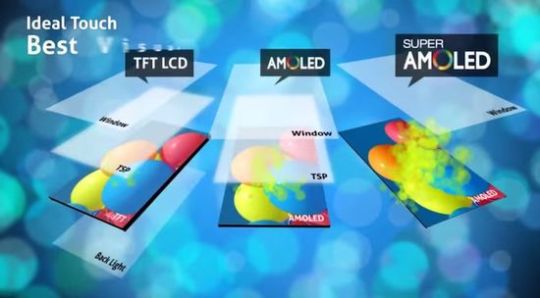
As a result, these screens are thinner, have less power consumption, provide absolute dust protection, a wider saturation of colors and a better image in direct sunlight. Unfortunately, they are more expensive compared to traditional AMOLED screens, and have high image grain due to the use of PenTile RGBG.
A similar technology in IPS matrices is called OGS (One Glass Solution).
Super AMOLED Plus and HD Super AMOLED differ only in the number of sub-pixels and, accordingly, size.

P-OLED matrices use a plastic screen backing instead of a glass. In addition to the traditional pros of OLED technology, this solution provides several additional advantages, including the ability to change the form factor of screens (flexible displays).
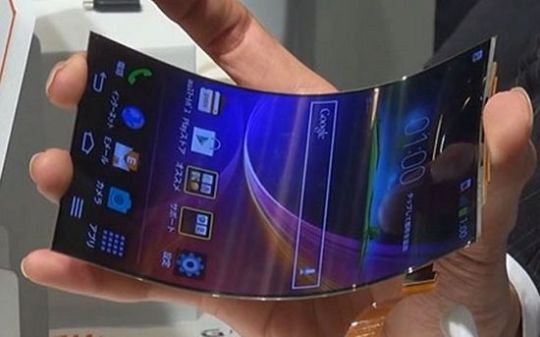
Samsung's latest Dynamic AMOLED version in Galaxy S10 5G is Super AMOLED with HDR10 support.
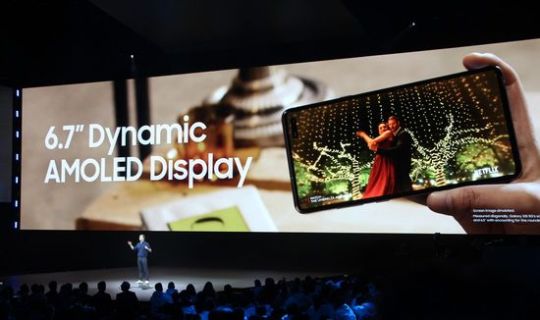
In addition, they form a less intense blue, which reduces eye strain and increases screen life.
Conclusion
In general, we can state the rapid development of AMOLED technology. Despite the higher price, AMOLED successfully competes with LCD displays, including Retina. Apparently, Samsung will continue to lead in this segment. But its success will significantly depend on the pricing strategy. In comparison, LG, the leader in the OLED TVs segment, has already offered the gorgeous 65-inch LG OLED C9 PUA for less than $ 2,500, which seemed unrealistic just a couple of years ago. It can be assumed that Samsung will also make efforts to lower the price of AMOLED screens.
This video shows a comparison of the iPhone 7+ with Retina LCD Display vs Samsung Galaxy S7 with Super Amoled.
Read the full article
#ActiveMatrixOrganiclight-emittingdiode#AMOLED#AMOLEDdisplayphones#dynamicAMOLED#GalaxyS105G#HDSuperAMOLED#OGS#OneGlassSolution#P-OLED#parallaxbackgrounds#PenTile#pixelshifting#RGBG#RGBW#superAMOLED
0 notes
Video
My Street by Eddy Summers
#lego#micro#macro#legomicro#microlego#moc#street#tree#plastic#house#roof#toy#pentax#pentaxk1#dfa100mm2.8#pixelshift#bricks
5 notes
·
View notes
Photo

Studio Wall by LoveAffairWithLife.com Pixelshift photo color graded. https://flic.kr/p/2kpAReA
0 notes
Photo

Photo by pixelshifter on Foter.com / CC BY-NC-SA
141 notes
·
View notes
Photo

Common emigrant butterfly pupa Shot with Fujifilm XH2 and XF-30mm #pupa #butterfly #fujifilmxseries #fujifilmglobal #gulfuphotography #naturelovers #butterflyphotography #fujifilmlove #pixelshift #natgeoyourshot #earthpic #grikart_macro #nationalgeographic #mta_macro #smallworld_uc #raw_insects #igbest_macros #macro_vision #macro_spotlight #gf_macro #expertphotography #themacromagic (at Gulfu Photography) https://www.instagram.com/p/CklUIwTPl6d/?igshid=NGJjMDIxMWI=
#pupa#butterfly#fujifilmxseries#fujifilmglobal#gulfuphotography#naturelovers#butterflyphotography#fujifilmlove#pixelshift#natgeoyourshot#earthpic#grikart_macro#nationalgeographic#mta_macro#smallworld_uc#raw_insects#igbest_macros#macro_vision#macro_spotlight#gf_macro#expertphotography#themacromagic
5 notes
·
View notes
Link
youtube
6 notes
·
View notes
Photo

playlist for a tomoya who didn’t know how to heckin handle their feelins for their two best friends, hajime & mitsuru, aka me
Mickey Valen - Ur Perfect I Hate It (feat. Emilia Ali)
Shawn Wasabi - Marble Tea
Louis The Child - Too Close (feat. Wrabel)
Whethan x Bearson - Win You Over (feat. Soak)
Tessa Violet - Crush (PIXELSHIFT Remix)
Galantis - True Feeling
#tomoya mashiro#hajime shino#mitsuru tenma#enstars kin#ensemble stars kin#playlist#king's kins#my gayass would have had this done three hours ago but I had to make 25+ dumplins and almost passed out from my chronic fatigue jkshgjk#free to use#i mean its a playlist so kfhdg#rabits
2 notes
·
View notes
Text
TOP list of the best 4K HDR projectors 2019

This review is updated regularly with new models
Last updated: 6 September, 2019
As known, almost all segments of modern consumer electronics offer a huge number of models and are characterized by intense competition. The segment of projectors, whose popularity is growing rapidly in recent years, also follows this trend. Of course, the abundance of offers pleases consumers, but sometimes it complicates the choice of the optimal model. Various TOPs help solve this problem. Of course, any TOP from experts is always subjective. Nevertheless, most successful models are present in many lists, which, of course, testifies to the objectivity of their assessment. Today, the following models are most often present in the TOP lists of various experts:
- BenQ HT3550 (2019) (W2700 in Europe), BenQ HT2550 (2018) and BenQ TK800 (2018) DLP projectors;
- Optoma UHD51A (2018) and Optoma UHD65 (2017);
- Epson Home Cinema 4010 (2018) (EH-TW7400 in Europe).
This list does not include the new 2019 models, with the exception of BenQ HT3550, and does not match the list of the best projectors according to consumers. But this situation is natural, as experts analyze first of all objective characteristics. Usually, new models have a maximum price in the absence of customer reviews. In turn, the opinion of consumers largely depends on the price, advertising credibility and positive feedback from other consumers. This review may be useful for those buyers who сhoose the most profitable home theater projector based on the actual specs of models.
BenQ HT3550 Ultra HD 4K HDR projector
BenQ introduced a new great 4K HDR projector, which claims to lead the list of the best budget Home Theater models. HT3550 continued the very popular series, which includes BenQ HT 3050, HT 2050, and HT 2050a.
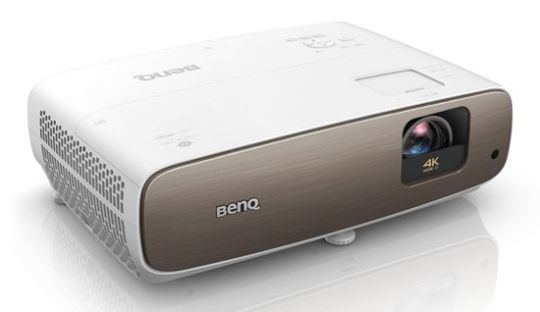
It appeared in April 2019 at a price of only $ 1,500. At the same time, this projector provides brightness of 2,000 Lumens, 30,000: 1 (full on / off with dynamic iris on) contrast, uses Dynamic Iris and supports Ultra HD 4K (3840 x 2160) resolution!
Main pros:
- TI 0.47-inch chip with four-phase pixel shifting provides 4K UHD (3840 x 2160) resolution;
- projector supports HDR10 and HLG HDR-standards;
- the new 0.47-inch next-generation DLP XPR chip minimizes the dark frame around the image (company also uses it in the HT5550);
- color accuracy from box reaches less than 3 Delta E for Rec.709, 100% Rec.709 coverage and 95% DCI-P3 coverage.
In addition, a 10-element, 8-group, all glass, 1.3x zoom lens projects 100-inch diagonal image from throw distance of nearly 8.25 to 10.75 ft (Throw Ratio of 1.13:1 - 1.47:1(D:W)).
Unfortunately, BenQ's default settings provide smaller gamut compared to max possible (95% DCI-P3 vs 105% DCI-P3), and input lag is too high for some modern games.
Other BenQ HT3550 key features:
- six-segment RGBRGB color wheel;
- 100% Rec.709 color gamut in D, 97% Rec.709 in Cinema mode at a higher brightness, and 95% DCI-P3 in the preset version;
- dynamic iris modes - Low, Middle, High, or Off;
- +10% vertical lens shift and ± 30 ° Vertical Keystone Correction;
- two 18 Gbps HDMI 2.0b, HDCP 2.2 ports;
- 4 color preset modes, one user mode for SDR, and modes for 3D, HDR10, and HLG;
- lockable ISF Night and Day mode support;
- silence mode blocks the pixel shift option, reducing the resolution to 1080p;
- color control system provides settings for RGBCMY hue, saturation, gain, and adjusts white balance for RGB gain and offset;
- 5-position HDR Brightness control;
- CineMaster video processing includes color enhancement, flesh tones, detail enhancement, and frame interpolation;
- two built-in 5-watt speakers;
- Full HD 3D playback support;
- backlit remote;
- Lamp Life is 4,000/ 10,000 /15,000 hours (Normal/Eco/SmartEco modes); replacement lamp costs $150, 3-year warranty, and 1 year on lamp.
Today, this model successfully competes with the popular Epson 5050UB, which is more than $ 1,000 more expensive.
BenQ HT2550 (2018)
Of course, this model does not require the introduction due to its enormous popularity in 2018. A significant reduction in the price, which today does not exceed $ 1,000, has provided it with a place in many TOP lists.
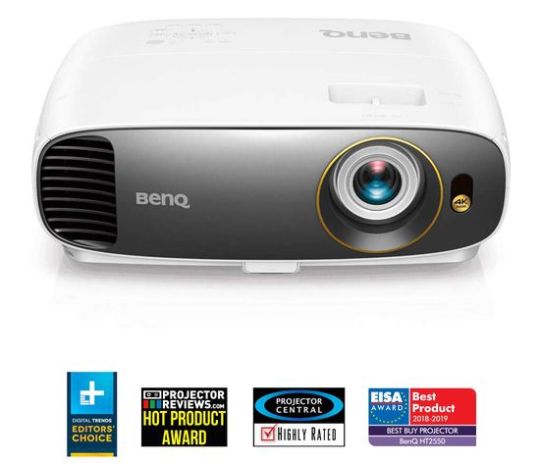
Model uses the 0.47" UHD DLP chipset and supports 3D. Additionally, the projector is quite compact and weighs under 10 lbs. In addition, the model has a built-in speaker with a very wide dynamic range for this size and provides keystone adjustment.
Basic specs also correspond to a fairly high level. The projector brightness reaches 2,200 Lumens with Ultra HD 4K (3840 x 2160) resolution and 10,000: 1 dynamic contrast. Its optics with Throw Ratio of 1.47: 1 - 1.76: 1 (Zoom Lens 1.20: 1) provides a 150-inch diagonal projection with Throw Distance nearly 17 ft (zooming 1.1x).
As usual for BenQ models, projector has a very bright factory calibration with a little green bias. It's convenient for compensating ambient light through windows.
HT2550 supports Brilliant Color mode, but without customization, for example, from 1 to 10. The projector provides only On or Off of this option. Brilliant Color provides about 80% of white in all color modes. Off mode reduces lumen output by about 20%, increasing color brightness to almost 100% of white. But, of course, the optimal perception of the image depends on the individual preferences of the person. Many viewers use Brilliant Color very rarely.
CinemaMaster Flesh Tone provides very simple adjustment for HDR Picture Quality.
Of course, high 3D performance is one of the main pros of the model, providing it a place among elite 4K projectors.
Unfortunately, input lag of 50 ms is quite suitable for most casual gaming only.
BenQ TK800 (2018) 4K UHD Home Theater projector
This no less popular model of 2018 today costs a little more than $ 1,000.

In fact, the BenQ TK800 is a brighter version of the BenQ HT2550. Of course, the increased brightness to 3,000 Lumens vs 2,200 Lumens in the BenQ HT2550 became their main difference. Other differences are less significant. For example, TK800 uses four-segment color wheel instead of six-segment in HT2550. Other specs of these models are almost identical.
Both models form a traditional dark frame around image, the dimensions of which do not exceed of 4.5% of the picture width or 5" for 120" diagonal image. As known, all models with 0.47" UHD DLP chip have this artifact. But most viewers do not notice it because of the high brightness and contrast of the image.
The BenQ TK800 supports 3D for 1080p content only, not including 4K. In addition, the projector does not recognize the 3D signal in automatic mode and requires the activation of 3D mode in menu.
In general, these models are very close in their specs, and a situational difference of about $ 100 from different sellers simplifies the choice between them.
Optoma UHD51A (2018)
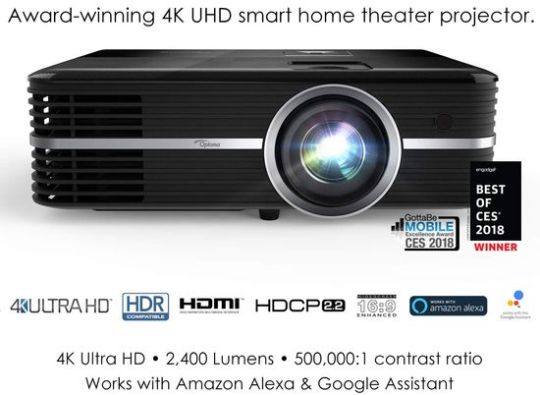
This model was first introduced in spring 2018 at a price of $ 1,700 and became the first 4K UHD HDR projector with voice-activation through Amazon Alexa.
This model is almost identical to the Optoma UHD50, which is cheaper by about $ 300. Both projectors use the RGBRGB color wheel and 0.47" DLP chip. But Optoma Smart Home Skill set for Amazon Alexa provides on / off and adjusting volume. In addition, the UHD51A additionally provides frame interpolation (FI), Full 3D support, a built-in USB media player for 4K video playback, and support for wireless display from mobile devices with an optional Wi-Fi dongle.
Main features:
- 3840 x 2160 resolution (4K UHD);
- Alexa support;
- four HDR modes;
- wide color gamut DCI-P3 , REC.2020, and REC.709;
- three levels of Frame Interpolation;
- two HDMI 2.0 ports;
- 1.3x zoom lens;
- vertical lens shift +15.0%;
- full 3D with DLP Link glasses;
- Lamp Life of 4000/10,000/15,000 hours in full power/ Eco / Dynamic modes at replacement cost $ 200;
- two 5-watt stereo speakers.
Its optics with Throw Ratio of 1.21:1 - 1.59:1 (Zoom Lens 1.30: 1) provides a 150-inch diagonal projection with Throw Distance nearly 14 ft (zooming 1.16x).
The list of model flaws includes:
- no keystone correction;
- relatively low brightness uniformity for this class;
- no Hybrid Log Gamma (HLG) support (HDR standard for broadcast TV);
- input lag reaches 68 ms.
Optoma UHD65 (2017)
This model has been consistently present in many TOP lists for 3 years.
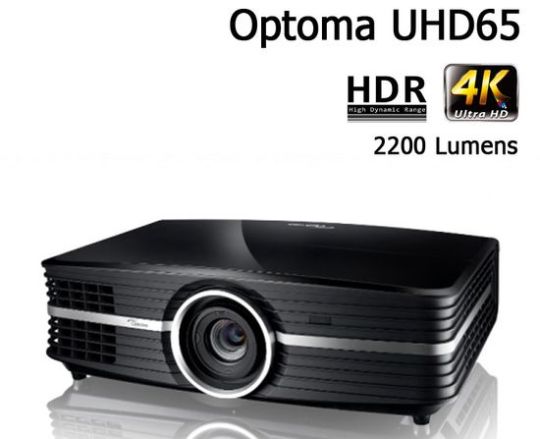
Today, it remains popular at a price of about $ 2,300.
This projector provides brightness of 2,200 lumens with 4K UHD (3840 x 2160) resolution at an unprecedented 1,200,000: 1 dynamic contrast. Its optics with Throw Ratio of 1.39:1 - 2.22:1 (Zoom Lens 1.60:1 ) provides a 150-inch diagonal projection with Throw Distance nearly 19 ft (zooming 1.3x).
In addition, it provides Vertical Lens Shift ± 15.0% and has Frame Interpolation mode to smooth the movements of highly dynamic content.
Unfortunately, it does not provide Digital Keystone, its weight reaches 16.0 lbs, and the input lag exceeds 74ms, which is a lot for modern games.
Epson Home Cinema 4010 (2018)
This super popular Epson 4K PRO-UHD Home Cinema projector is also well known in the market since autumn 2018.
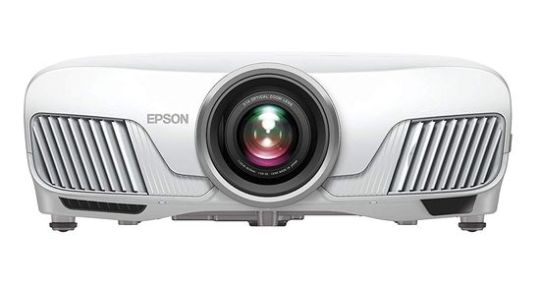
At that time, it cost $ 1,900. Epson 4010T is the latest in a line of 4K-compatible projectors, which provide "4K Enhanced" resolution at native 1080p LCD imagers. According to the company, this pixel-shifted projector uses an advanced algorithm that provides even better image quality compared to traditional 4K projectors.
This projector provides brightness and CLO (Color Light Output) of 2,200 lumens with 1920 x 1080 resolution (4K w/pixel shifting) at 200,000:1 (full on/off) contrast ratio. Its optics with Throw Ratio of 1.35:1 - 2.84:1 provides a 120-inch diagonal projection with Throw Distance nearly 12 ft (zooming 2.1x).
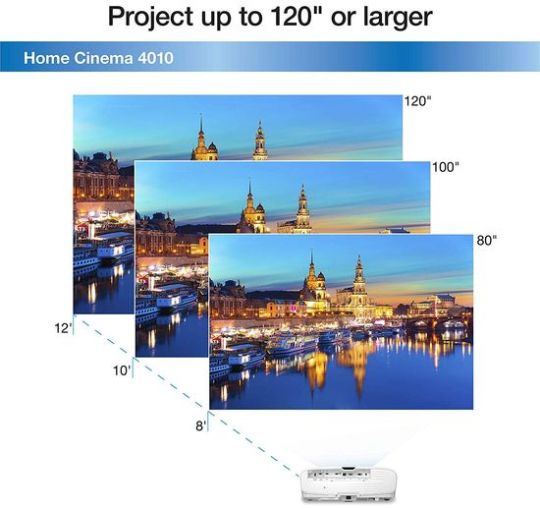
PROS
- 3LCD design without rainbow artifacts;
- improved 4K PRO-UHD pixel shifting for input signals up to 4096 x 2160;
- exelent 15-element glass lens provides even light throughput and eliminates chromatic aberrations;
- lens memory saves up to 10 positions for CIH (Constant Height Image) installations on a CinemaScope 2.4:1 screen without an anamorphic lens;
- Full HD 3D support;
- brightness of 2,400 lumens for colors and white;
- auto-iris to optimize dark scenes provides 200,000:1 rated contrast ratio;
- 100% of DCI-P3 color space;
- color depth up to 12-bit for standard dynamic range content and 10-bit for HDR;
- 2.1x motorized zoom with ± 96% vertical and ± 47% horizontal lens shift;
- 1080p 3D support;
- optional WiFi dongle.
CONS
- no support for 4K/60 Hz HDR;
- Frame Interpolation for 1080p/24 signals only.
Conclusion
Naturally, that 4K HDR projectors from segment leaders, including BenQ, Optoma, and Epson among the TOP lists of many experts.
All these models have excellent specs and are great for Home Theater with a screen size of 120" or more. Moreover, today their price mainly varies from $ 1,000 to $ 2,000, which is comparable with the cost of modern TVs with a diagonal of 65".
Unlike other projectors, the BenQ HT3550 is the 2019 model. As a result, it uses the most innovative solutions, including the new 0.47-inch next-generation DLP XPR chip. Therefore, this relatively cheap model with excellent specs may well take pride of place among Best Sellers. But, of course, the final choice depends on the user's preferences.
We sincerely wish you the Right Solution!
This video shows the BenQ HT3550 playing 4K H.264 (120Mbps).
Read the full article
#0.47-inchnext-generationDLPXPRchip#4KEnhanced#BenQHT2550DLPprojector#BenQHT35504KHDRDLPprojector#BenQTK800DLPprojector#BenQW2700DLPprojector#best4KHDRprojectors#CIH#CLO#colorlightoutput#ConstantHeightImage#DLPXPRchip#EpsonEH-TW7400projector#EpsonHomeCinema4010projector#HLG#HybridLog-Gamma#OptomaUHD51A#OptomaUHD65#pixelshifting#VerticalLensShift
0 notes
Photo

Waldmotive by Lutz Blohm viele Details mit Pixelshift https://flic.kr/p/2iEzi5p
2 notes
·
View notes
Photo

#hessen #way #forest #green #autumn #rocks #moss #trees #wallpaper #sunthroughtrees #pentaxk1 #pixelshift #stitching #landscapephotography #bsfotomedia #pentaxians #pentax #leaves (hier: Hessen, Germany)
#wallpaper#hessen#green#pixelshift#trees#pentaxians#sunthroughtrees#pentax#moss#landscapephotography#bsfotomedia#leaves#autumn#way#rocks#pentaxk1#forest#stitching
0 notes
Photo

Warrenville Grove
0 notes
Photo



Preparando Moodboard floreali in attesa del Burian
Anche questo mese di febbraio si avvia a terminare e io qui sto preparando il mio primo shooting indipendente per il mese prossimo. Dato il calendario il mio primo pensiero fu quello di realizzare un moodboard in linea con le prime fioriture. Certo non un’idea originale in sé, ma ciò non vuol dire che non si possa addentrarsi dentro un tema già visto e riuscire a dargli una lustratina, se non proprio a rinnovarlo magari, forse, si spera. Di certo è una sfida, e questo ci piace in quanto tale.
Il meteo, però, strepita da giorni che sta per arrivare un’ondata di vento gelido dalla Siberia la quale, stando alle previsioni, ci porterà quasi un’intera settimana sotto lo zero (anche per le massime), la qual cosa mi fa temere per lo stato in cui troveremo la flora, quando finalmente giungerà il giorno dell’atteso shooting.
Pertanto, di documenti ne dovrò produrre come minimo due. Volendo, si potrebbe dare un’idea di “fioritura” e di “primavera” anche al chiuso, con fiori e prop adatti vari presi da un fioraio, ma non so se e quanto ciò potrà essere possibile - la disponibilità di uno casa o ce l’ha la modella o nisba... ma non è esattamente la mia idea principale quella di chiudermi da qualche parte.
Fondamentale, per me, è scattare con luce naturale, è questo il tipo di Fotografia che mi interessa sviluppare e le attuali macchine fotografiche hanno un po’ tutte (di certo le mie due K3) una buona qualità d’immagine anche a ISO (la sensibilità del sensore) alti. Da esperienza, entro ISO 2000 i file della mia Pentax sono abbastanza puliti, fra 2000 e 4000 si evidenzia della grana sì, ma senza colori strani e il dettaglio resta tutto, fra 4000 e 6400 magari converrebbe scattare più in BN, ma dipende molto dalle condizioni di luce.
Insomma, avrei quanto serve per mettere alla prova pratica la teoria fotografica che intendo seguire e per cui non esiste una buona o cattiva luce, la Luce è Luce, sempre, bisogna adattarsi a quella disponibile.
Se il Burian dovesse bruciare i fiori delle bulbacee, lasciando il parco brianzolo in cui ci aggireremo, spoglio... beh chi l’ha detto che dovrei forzare la situazione per forza rendere, contro la realtà dei fatti, un’idea di gioiosa fiorescenza? Potrei benissimo realizzare scatti che rendono un’idea di abbandono, di terra bruciata, di abbandono.
Anche questo ordine di pensieri e conseguenti scelte di scatto, contribuiscono a fare uno stile.
Per Aspera ad Astra, sarà comunque un successo!
#photography#photography practice#fashion photography#moodboard#preparation#burian#flowers#choices#photographic style#searching
10 notes
·
View notes
Photo
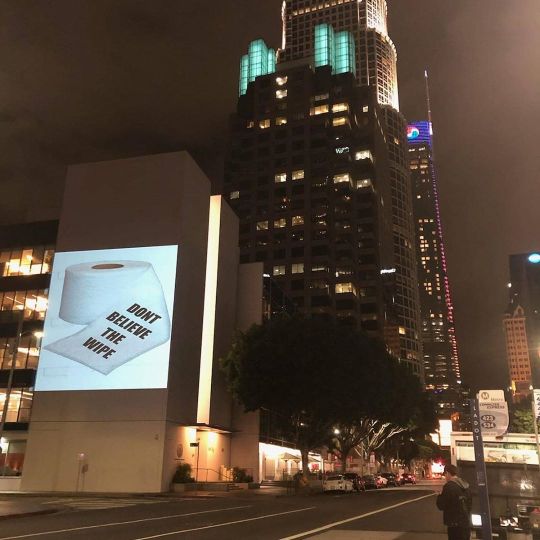
Don't believe the wipe By @pixelshift https://www.instagram.com/p/B9nnNmqB6o_/?igshid=1k8rdndo4dewz
0 notes


